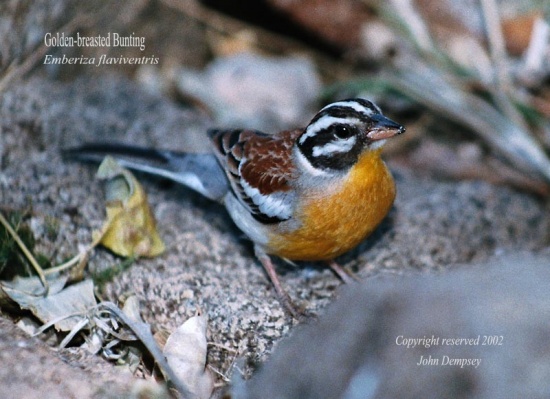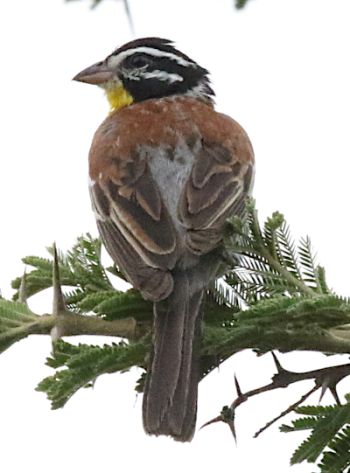Alternative name: African Golden-breasted Bunting
- Emberiza flaviventris
Identification
15-16cm
Male
- White crown
- Black lateral crown stripes
- White supercilium
- Black-bordered white ear coverts
- Orange-yellow underparts
- Yellow throat
- Whitish lower belly
- Chestnut upperparts
- Grey rump
- Brown wings with two white wing bars
Sexes are very similar, but females - buff tone to head, browner head stripes, and the back may have dark streaks.
Young birds are duller and paler than the females.
Distribution
Africa, south of the Sahara; absent from the equatorial forest belt.
Western Africa: Mauritania, Senegambia, Senegal, Mali, Liberia, Burkina Faso, Benin, Nigeria, Niger, Chad, Cameroon, Central African Republic, Equatorial Guinea, Gabon, DRC and Angola
Eastern Africa: Sudan, South Sudan, Eritrea, Ethiopia, Kenya, Uganda, Rwanda, Burundi, Tanzania, Zambia, Mozambique and Malawi
Southern Africa: Namibia, Botswana, Zimbabwe, South Africa, KwaZulu-Natal, Lesotho and eSwatini
Taxonomy
Subspecies
There are four subspecies[1]:
- E. f. flavigaster: Southern edge of Sahara from Mauritania to Eritrea. [paler, redder back, pale grey rump, paler yellow underparts and whiter flanks]
- E. f. kalaharica: Southern South Sudan and central and southeastern Angola south to northeastern Namibia, Botswana, Mozambique, and northern South Africa
- E. f. flaviventris: Southern and eastern Cape Province to KwaZulu-Natal
- E. f. princeps: Northern and north-western Namibia to south-western Angola. [similar to nominate, but larger, and paler below]
Habitat
Dry open woodlands.
Behaviour
Primarily a highland species found either in pairs or singly. They are mainly seen foraging on the ground (although males can sometimes be seen singing from the tops of trees).
Breeding
They build a cup nest lined with fine grass or hair low in a shrub. The 2-3 glossy, black-lined, white or cream eggs are incubated for 12-13 days; the young fledge in another 16-17 days.
Diet
A ground feeder, the diet includes seeds, insects and spiders and sometimes larger creatures when the birds have young to feed.
References
- Clements, J. F., T. S. Schulenberg, M. J. Iliff, D. Roberson, T. A. Fredericks, B. L. Sullivan, and C. L. Wood. 2017. The eBird/Clements checklist of birds of the world: v2017, with updates to August 2017. Downloaded from http://www.birds.cornell.edu/clementschecklist/download/
- Avibase
- birdwatching.com.na
Recommended Citation
- BirdForum Opus contributors. (2025) Golden-breasted Bunting. In: BirdForum, the forum for wild birds and birding. Retrieved 3 May 2025 from https://www.birdforum.net/opus/Golden-breasted_Bunting
External Links
GSearch checked for 2020 platform.1





